This week’s post follows the path well trod by respected writing teachers, showing how Story Beats apply to Act 1 of L. Frank Baum’s action fantasy, The Wonderful Wizard of Oz.
Recap from Last Week
Time-proven story structures inspired me to create this Story Beats infographic.
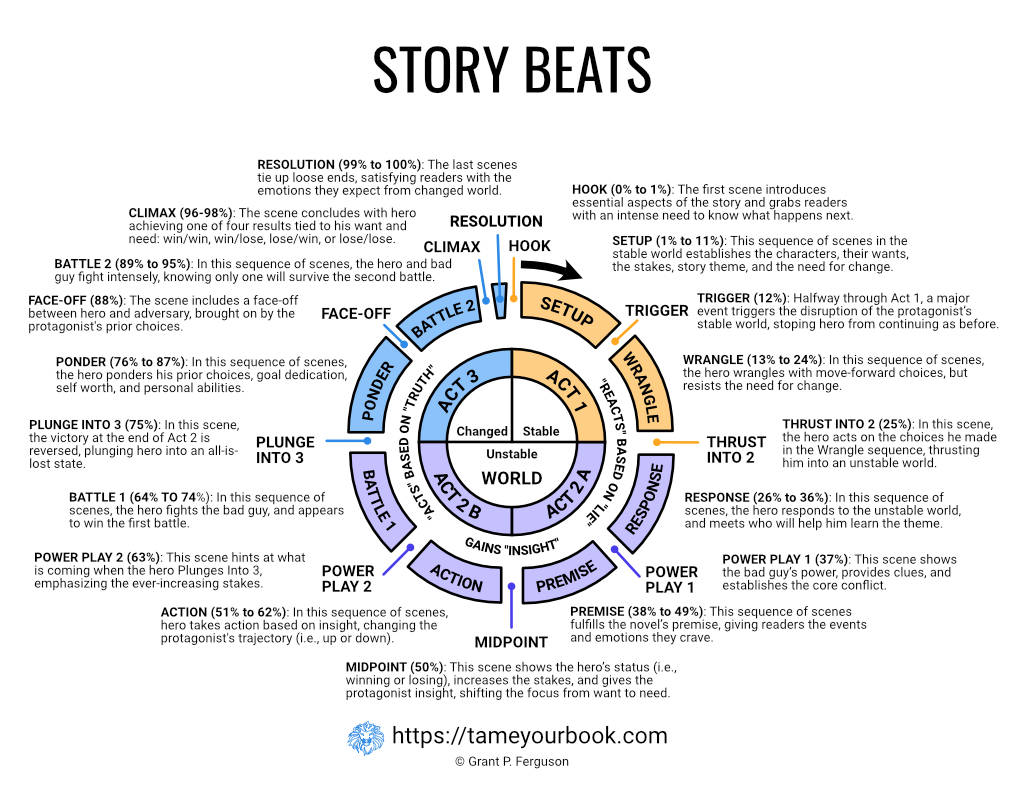
The name is not important. What’s significant is these beats allow you to break down films and books into patterns that consistently work. Those effective formats are as old as storytelling.
If you missed last week’s post, I encourage you to read Do You Want to Personalize Story Structure? Now You Can! – Part 1.
Principles, Not Rules
There is no single right way to structure stories. Instead, the beats are like a map, not a formula. Writers remain in control of all elements.
Many (but not all) story structures adhere to three acts. Stories start with a stable world, and at the end of the first act, a disruptive event thrusts the chief protagonist into the unstable world of the second act. After a series of events, the lead character plunges into the changed world of the third act. The Story Beats divide the second act into sub-parts A and B.
This series refers to the divisions as Act 1, Act 2A, Act 2B, and Act 3.
Scenes and Summaries
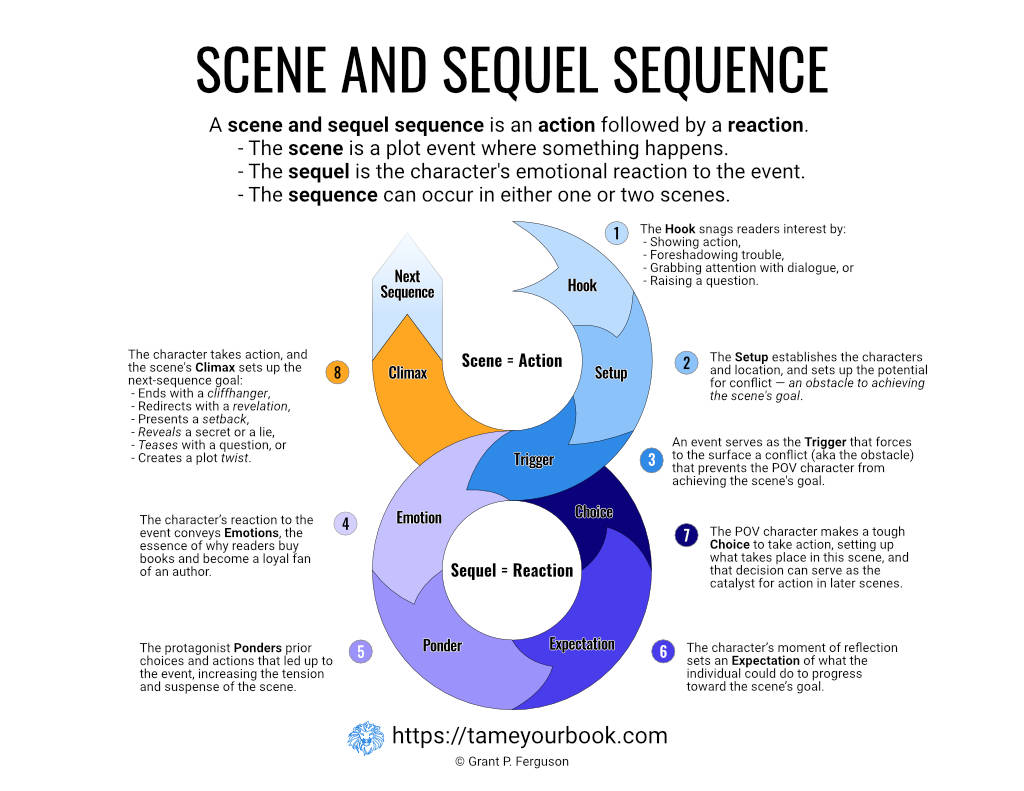
I separated Baum’s work into scenes, linked each synopsis to the full text of an online copy, added illustrations by W. W. Denslow, and based the divisions and summaries on sub-beats (shown as lowercase to differentiate from the uppercase Story Beats).
The answers to questions tied to the Scene & Sequel Sequence Beats are my interpretations of the story. Your perspectives may differ, and that’s okay. Our creative differences can surprise and delight audiences!
Full Text Available for Each Scene
Click on a scene link (e.g., Scene 01) to see the full text from The Wonderful Wizard of Oz in a separate browser tab.
Masterwork Analysis
In this week’s post, we’ll analyze 1 through 5 of the 18 Story Beats: SETUP, HOOK, TRIGGER, WRANGLE, and THRUST INTO 2.
1. SETUP

Beat Overview
This sequence of scenes in the stable world establishes the characters, their wants, the stakes, story theme, and the need for change. Note: The HOOK is part of the SETUP sequence of scenes.
The scenes introduce the supporting cast of characters, the chief protagonists goal (i.e., the “want”), the lead character’s reluctance to change (i.e., the “need” to learn a life lesson), hints at the stakes (i.e., the bad things that will happen if unsuccessful attaining goal), and something happens that makes the lead appealing to readers.
A character (typically not the chief protagonist) hints at what the lead must learn to satisfy the need (e.g., forgiveness, love, acceptance, faith, fear, trust, survival, selflessness, responsibility).
The SETUP combines elements intended to resonate with the audience’s emotions.
Beat Questions
- Have you established the chief protagonist of the story? Dorothy is a young orphan.
- Have you shown the lead’s major issues and flaws? She looks to others for happiness and the scene foreshadows she needs to learn “self-sufficiency” to overcome adversity.
- Have you introduced other essential characters?
- Protagonists: Dorothy (orphaned young girl); Toto (little black dog);
- Antagonists: Environment – Weather
- Support: Uncle Henry (farmer); Aunt Em (farmer’s wife);
- Is the stable world established before the TRIGGER event? The stable but sober gray world contrasts with merry Dorothy and Toto, and comes before the TRIGGER event.
- Has a character raised the story’s theme? The scene hints Dorothy depends on home life for her happiness.
- Is the chief protagonist’s need clear, one that demands an urgent change? The scene contains a hint that Dorothy depends on others, which she gets from Uncle Henry and Aunt Em despite the dour setting and their sober gray demeanors.
- Will the chief protagonist, characters, issues, and External Theme resonate with target readers? The young girl and little black dog will probably resonate with young audiences who like the action fantasy genre.
Beat and Scene Summary
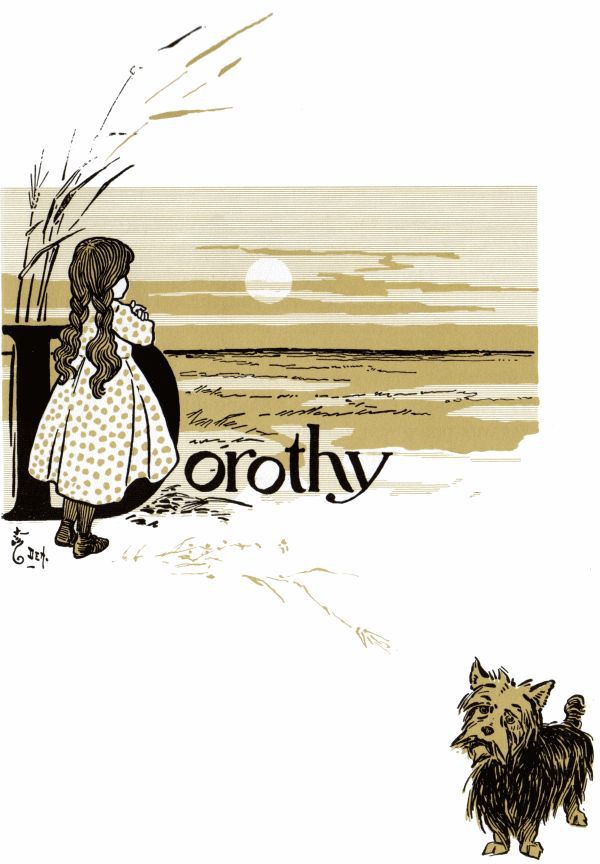
- Scene 01: An opening image of a rundown rural farm, including descriptions of gray setting and people to emphasize the dismal conditions. In contrast, Dorothy and Toto play and laugh. Aunt Em still doesn’t know how Dorothy can laugh given the conditions. When orphan Dorothy first came to live with them, the child’s laughter triggered a negative reaction from Aunt Em. Now, despite the bleak environment, Toto makes Dorothy laugh.
2. HOOK

Beat Overview
The scene introduces essential aspects of the story and grabs readers with an intense need to know what happens next. Note: The HOOK is part of the SETUP sequence of scenes.
These critical details convey what the story is about, establish the actions required for upcoming events (e.g., characters and settings), and entertain readers (i.e., maintain interest).
The HOOK is an opportunity to make the chief protagonist appealing (i.e., likable), doing something that humanizes the character and hinting at one or more flaws through the lead’s thoughts, choices, conversations, or actions.
Beat Questions
- Is the HOOK visual? Readers see Uncle Henry and Dorothy scanning the sky, listening to the low wailing and whistling of the wind, and watching the grass bow in waves from the southerly wind.
- Does the HOOK hint of the past (but avoids an information dump)? Aunt Em washing dishes ties to the SETUP scene, which described how Dorothy’s foster parents must eke out a living.
- Does the scene instill in readers a need to know what happens next? The scene has sinister overtones, encouraging continued reading.
- Is at least one of chief protagonist’s flaws shown or at least hints of one or more issues? No issues are hinted at in this scene, but the overall SETUP suggests Dorothy is dependent on others for her happiness.
- Does the HOOK establish the genre without giving away too much, and puts readers in the right mood? The scene hints of upcoming action.
- Do readers sense this HOOK is before the TRIGGER event? This HOOK intrigues readers to find out what happens, but it does not disrupt the protagonist’s life.
- Is there a theme motif established in HOOK and planned for mirroring in the RESOLUTION? Home and family are important, and scene mentions Uncle Henry, Aunt Em, and Toto—Dorothy’s best friend.
Beat and Scene Summary
- Scene 02: On this day, Dorothy and Toto are not playing. Uncle Henry scans the grayer than usual sky, and a low wailing wind howls. They see the powerful southerly wind ripple the grass, and keep watching for what’s coming from that direction.
3. TRIGGER

Beat Overview
A major event triggers the disruption of the protagonist’s stable world, stopping the lead character from continuing as before.
The event is so disruptive, it will eventually thrust the chief protagonist into Act 2’s unstable world, and the lead cannot return to the way things were before the TRIGGER event.
Note: In the upcoming WRANGLE sequence, the lead resists the urge to engage, and instead, searches for some way to return to the way of life before the TRIGGER event.
Beat Questions
- Is the TRIGGER some action that happens to the lead? The tornado influences the lives of Dorothy and her family.
- Does TRIGGER break stable-world patterns, preventing protagonist’s return to old life? The tornado carries Dorothy and Toto miles away from their old life, and at the end of the scene, it’s not clear if they can ever return.
- How has the lead’s life changed by TRIGGER? The tornado separated Dorothy and Toto from Uncle Henry and Aunt Em.
- Did the TRIGGER force the lead into action? When the little dog fell through the trapdoor, Dorothy sprang into action and saved Toto.
- Is the TRIGGER believable (relatable) to target readers? From an early age, people learn of weather dangers, especially tornadoes.
Beat and Scene Summary

- Scene 03: Uncle Henry yells, “There’s a cyclone coming, Em.” Uncle Henry, Aunt Em, and Dorothy get ready to run for the cellar, but Toto jumps out of the little girl’s arms. Should Dorothy find Toto or run for the cellar? She catches Toto, but they stay in her bedroom. As the cyclone twirls the house, Toto runs around the room and falls through the trapdoor. Dorothy saves Toto, and later, they fall asleep on her bed.
4. WRANGLE

Beat Overview
In this sequence of scenes, the protagonist wrangles with move-forward choices but resists the need for change. As the lead debates the situation with self and others, this scene leverages the doubt and resistance established in the TRIGGER scene.
Beat Questions
- Is there a valid argument for the chief protagonist to move forward? Dorothy finds herself in a strange land and separated from those she loves; thus, she has a valid argument to figure out what happened (the “story problem”) and discover how to return home (the “story goal”).
- Is it the lead who wrangles with self? Naturally curious, Dorothy questions herself and others.
- Do these debates give us insight into the chief protagonist’s emotions? She listens intently (“wonder”) and can’t believe (“doubt”) she killed anything.
- Do the scenes give a sense of why the lead is reluctant to advance? As a young girl, she perceives the need for help from others, and appears somewhat reluctant to embrace self-sufficiency to overcome the situation.
- How does this reluctance affect other areas of the lead’s life? She looks for help to find her way home, and sobs (“sadness”) when it seems impossible to return to Kansas. Dorothy pleads for others to go with her and seek help from the Great Oz.
Beat and Scene Summary
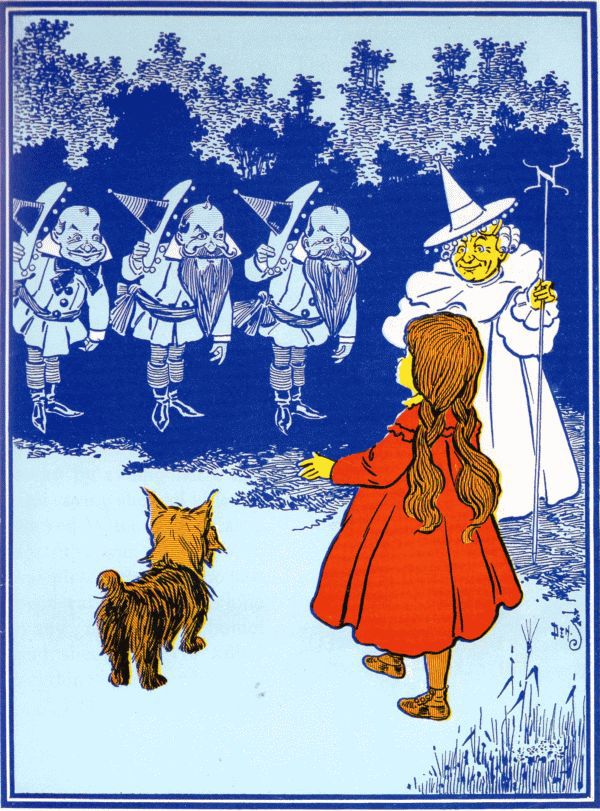
- Scene 04: Dorothy, awakened by a shock, realizes she’s no longer in the gray world of the dry prairies. She takes stock of her surroundings, a country of marvelous beauty. Dorothy notices a group of the strangest people she had ever seen. She wonders who they are? Dorothy studies them intently, fixating on the little and much older woman with nearly white hair, covered with wrinkles, and who walked rather stiffly.

- Scene 05: The unusual people drew near, and the older woman spoke, thanking Dorothy for killing the Wicked Witch of the East and pointing to victim’s two feet sticking out from underneath the house. The dead witch wore silver shoes with pointed toes. Dorothy can’t believe what she hears, and denies she killed the witch. The Good Witch answers Dorothy’s questions, describing the Munchkins, witches, and land. The Munchkins point to the corner of the house where the Wicked Witch had been lying.

- Scene 06: The Good Witch pointed for Dorothy to see the Wicked Witch’s feet had disappeared, leaving the silver shoes with unknown powers. [Note: The silver shoes represent the Q-factor, the thing that ultimately allows the chief protagonist to fulfill the story’s theme.] Dorothy asks for help to return home, but she’s told it’s impossible. Dorothy frets over her inability to get home. The Good Witch’s slate magically displays, “LET DOROTHY GO TO THE CITY OF EMERALDS.” The little old woman encourages Dorothy to follow the road paved with yellow brick and seek help from the Wizard of Oz.
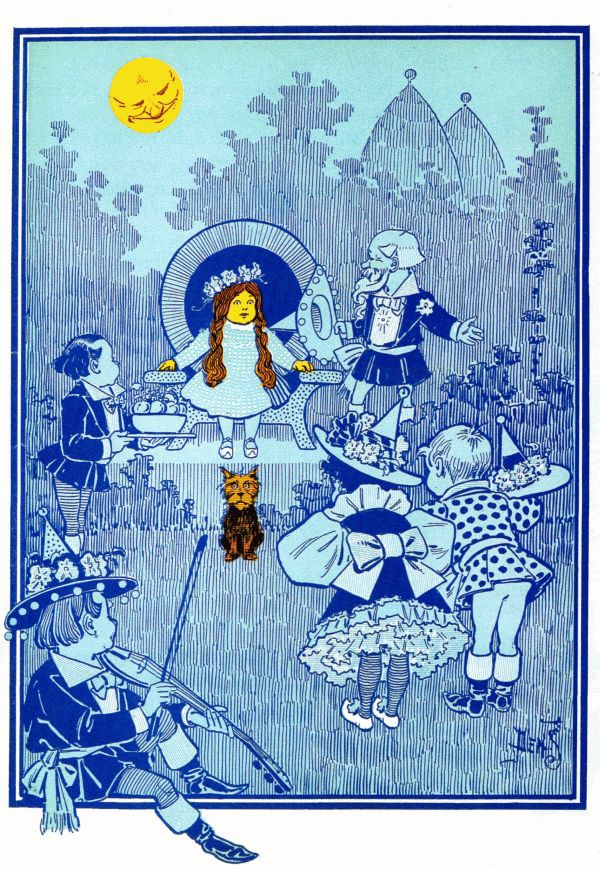
- Scene 07: Dorothy prepares for her journey to the Emerald City. She follows the yellow brick road to Boq’s home—the richest Munchkin. Boq calls her a “friendly witch” because she wears the silver shoes. Dorothy wonders how long the journey is and worries of the dangers. She meets the Scarecrow, helps him down from the high pole, but he can’t tell her about Oz or the Emerald City because he lacks a brain. As they journey, the Scarecrow admits his greatest fear, “It’s a lighted match.”

- Scene 08: The journey is arduous. Dorothy and Scarecrow discuss the countryside and each other’s history. Dorothy explains her motivation, stating, “There is no place like home.” [Note: Chief protagonist states external theme.] Scarecrow describes how the farmer made him and his sadness because he lacks a brain. They continue on through the dark forest, led by Toto, until they find a cottage. Dorothy sleeps, but Scarecrow, who never tires, waits patiently for the morning.

- Scene 09: Dorothy awakes to find Scarecrow waiting patiently. They must search for water to wash and drink, emphasizing not much bread left for her and Toto. Dorothy hears a groan in the woods and discovers a rusted Tin Woodman. She asks, “What can I do for you?” Tin Woodman wants oil. While oiling the tin man, Dorothy tells him they’re off to see the Wizard of Oz. Tin Woodman asks if the Wizard can give him a heart. Scarecrow says he wants a brain. Tin Woodman explains how he lost his heart because of the Wicked Witch of the East, and he wants a new one. Dorothy worries about food as she continues her journey, accompanied by Toto, Scarecrow, and Tin Woodman.
5. THRUST INTO 2

Beat Overview
In this scene, the chief protagonist acts on the choices made in the WRANGLE sequence, thrusting the character into an unstable world of Act 2A.
The epic moment happens when the lead moves forward, leaves the comfort of the stable world, tries something new, or thinks in different ways. It’s a decisive action scene that separates the stable world of Act 1 from the unstable world of Act 2.
Throughout Act 1, the chief protagonist grows more aware of what will become the story goal—the effort it will take to resolve the story problem. This event solidifies the story goal as the lead is THRUST INTO 2, an irreversible action—a point of no return.
The big event that compels the lead to accept a call to action (i.e., the lead chooses the story goal to resolve the story problem), leaving the stable world of Act 1 for the unstable world of Act 2—an irreversible action and point of no return.
Beat Questions
- Does chief protagonist leave old life and do something new? With her companions, Dorothy has left her prior life.
- Is the new opposite of the old? Yes. Before, Dorothy led a sedate life in the gray world of Kansas, content to live with Uncle Henry and Aunt Em. In the stable world, only Toto gave her a reason to show emotions. Now she has three new companions, and the unstable world elicits worries, fears, and excitement.
- Does the lead make the critical choice based on want (not need)? Dorothy moves forward because of her want to return home (not because of her need to attain self-sufficiency).
- Is it clear why this might be the wrong choice? With their continued travel to the Emerald City, Dorothy and friends will face dangers and even the potential for death.
- Was the chief protagonist’s choice a conscious one? Yes. Dorothy voiced her decision, echoed by her three companions.
- Does the lead have an obvious goal going into Act 2? Yes, to reach the Emerald City and have Oz send her back to Kansas.
- Which character will help chief protagonist learn the inner theme? Although not conclusive in this scene, there are hints that the combination of Scarecrow, Tin Woodman, and Cowardly Lion will help Dorothy learn the internal theme: self-sufficiency. Note: When self-sufficiency prevails, a person is not dependent on others to overcome adversity (e.g., through self-sufficient choices, an individual can avoid becoming a victim of other people’s agendas).
Beat and Scene Summary

- Scene 10: Dorothy asks Tin Woodman how long before they’re out of the dark forest? The Tin Woodman describes the dangerous journey, noting how the Good Witch’s kiss protects Dorothy. [Note: A foreshadow that Dorothy already possesses the ability to overcome the adversity of the unstable world.] A great lion roars, and with one paw, sends Scarecrow spinning and then knocks down Tin Woodman before chasing after Toto. Dorothy worries about Toto, shaming lion for threatening her dog. After Dorothy rebukes the lion’s cowardly act, lion asks about each traveler, and Dorothy explains their physical and emotional makeup. Lion describes why he’s a coward. After hearing what others want from the Wizard, the lion joins the journey to ask Oz for courage.
Act 1 Wrap Up
Regardless of whether you like to preplan your writing or prefer to free-write and edit later, story structure enables you to surprise and delight readers.
Next week’s Act 2A will show how L. Frank Baum had Dorothy and friends deal with events in the unstable world.
Related Posts
1. Do You Want to Personalize Story Structure? Now You Can! – Part 1
2. Do You Want to Personalize Story Structure? Now You Can! – Part 2
3. Do You Want to Personalize Story Structure? Now You Can! – Part 3
4. Do You Want to Personalize Story Structure? Now You Can! – Part 4
5. Do You Want to Personalize Story Structure? Now You Can! – Part 5
6. Do You Want to Personalize Story Structure? Now You Can! – Part 6
Resources
Leave a Reply
I value your feedback, so let me know what you think!
Do you like to preplan with story structure, or use it later to edit your manuscript, and based on your preference, how does that influence your writing?

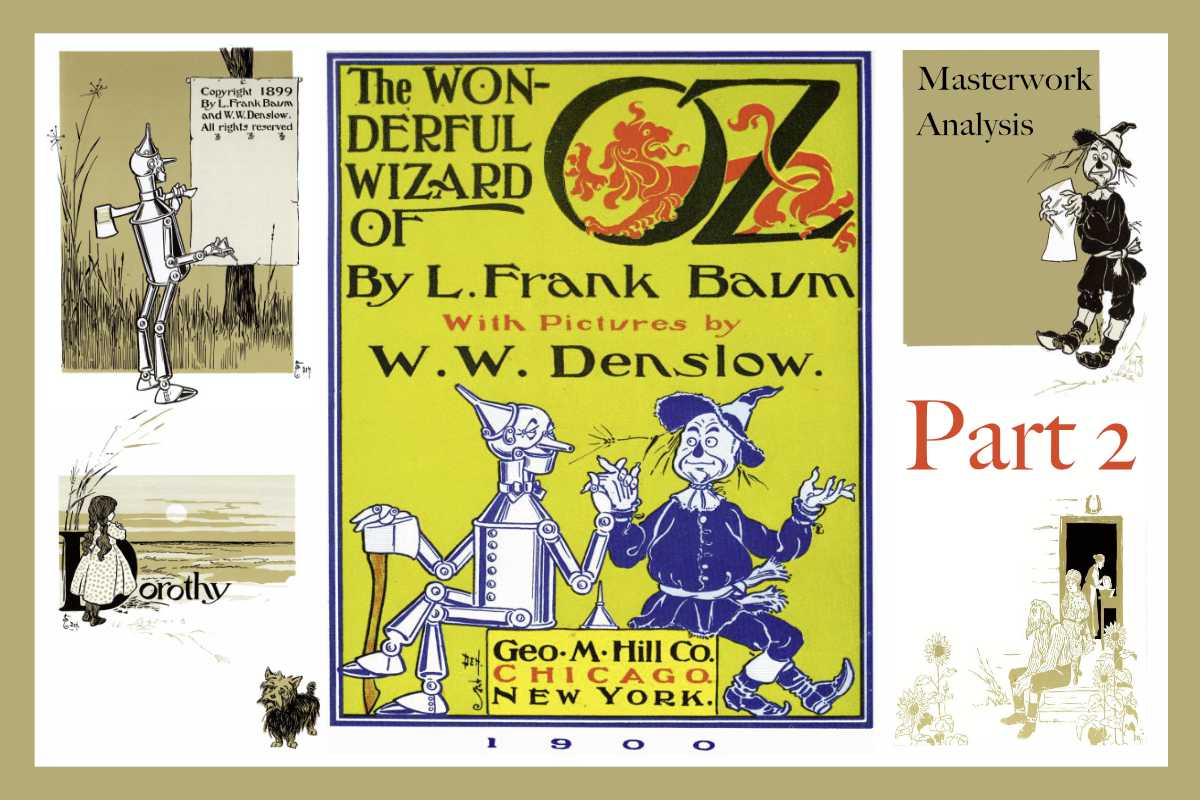
3 responses to “Do You Want to Personalize Story Structure? Now You Can! – Part 2”
So much detail. I remember reading the Marshall Plan–like this but less thorough. He called ‘wrangle’ ‘reaction’. It was the first time I’d thought about the importance of reacting to major events. Well done, Grant.
Thanks, Jacqui. Going through another author’s book brings so many opportunities to the surface. In the final wrap-up, I’ll highlight those “aha” moments, linking what I learned to 5-Step Storytelling.
Sounds great! People like me love steps we can tick off–done, done, done!